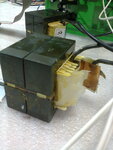T
treez
Guest

Hello,
We need to produce a 180uH Boost PFC inductor for a 3.7kW PFC. (Fsw = 45kHz).
Minimum VAC input is 216VAC.
Inductor RMS Current = 25 Amps max.
Inductor peak current = 39 Amps
Vout of PFC is 400V.
None of the Epcos range of ferrite cores with bobbins can manage this. We have been forced to use stacked Toroids by Magnetics Incorporated. We find that we will need to glue together four toroids of part number 77615A7. We will then need to wind 26 turns of litz wire round this four_torroid stack. The litz wire will comprise 9 strands of 22SWG enamelled copper wire (0.71mm diameter). The total winding resistance is 41 milliohms, leading to a winding loss of 25 Watts at minimun VAC(in), max P(out).
Toroid datasheet (part number = 77615A7)
https://www.mag-inc.com/home/Advanced-Search-Results?pn=77615
This torroid is of “kool mu” material. Its permeability changes with the instantaneous current flowing through it. Thus over one mains half cycle, the inductance of the boost inductor will change very significantly. I tried to arrange it so that the inductance of 180uH is what we get at the inductor peak current value. The torroid datasheet has a graph of AL value vs Ampere.Turns. I used the AL value that corresponds to an Ampere turns of [39 Amps * 26 Turns].
Do you know of any more suitable ferrite core for this, that doesn’t change its inductance with the instantaneous current level.?
Also there is no bobbin or mounting assembly for this DIY torroid stack. I think we will have to just “glue” it to the PCB with a load of high temperature silicone. Do you agree?
We need to produce a 180uH Boost PFC inductor for a 3.7kW PFC. (Fsw = 45kHz).
Minimum VAC input is 216VAC.
Inductor RMS Current = 25 Amps max.
Inductor peak current = 39 Amps
Vout of PFC is 400V.
None of the Epcos range of ferrite cores with bobbins can manage this. We have been forced to use stacked Toroids by Magnetics Incorporated. We find that we will need to glue together four toroids of part number 77615A7. We will then need to wind 26 turns of litz wire round this four_torroid stack. The litz wire will comprise 9 strands of 22SWG enamelled copper wire (0.71mm diameter). The total winding resistance is 41 milliohms, leading to a winding loss of 25 Watts at minimun VAC(in), max P(out).
Toroid datasheet (part number = 77615A7)
https://www.mag-inc.com/home/Advanced-Search-Results?pn=77615
This torroid is of “kool mu” material. Its permeability changes with the instantaneous current flowing through it. Thus over one mains half cycle, the inductance of the boost inductor will change very significantly. I tried to arrange it so that the inductance of 180uH is what we get at the inductor peak current value. The torroid datasheet has a graph of AL value vs Ampere.Turns. I used the AL value that corresponds to an Ampere turns of [39 Amps * 26 Turns].
Do you know of any more suitable ferrite core for this, that doesn’t change its inductance with the instantaneous current level.?
Also there is no bobbin or mounting assembly for this DIY torroid stack. I think we will have to just “glue” it to the PCB with a load of high temperature silicone. Do you agree?






